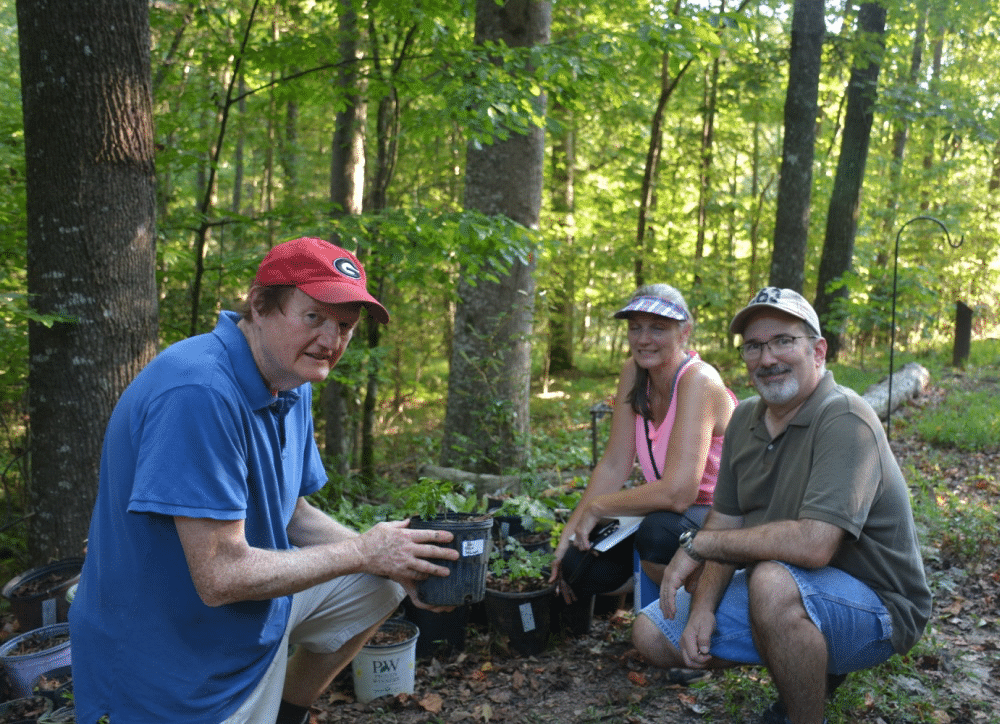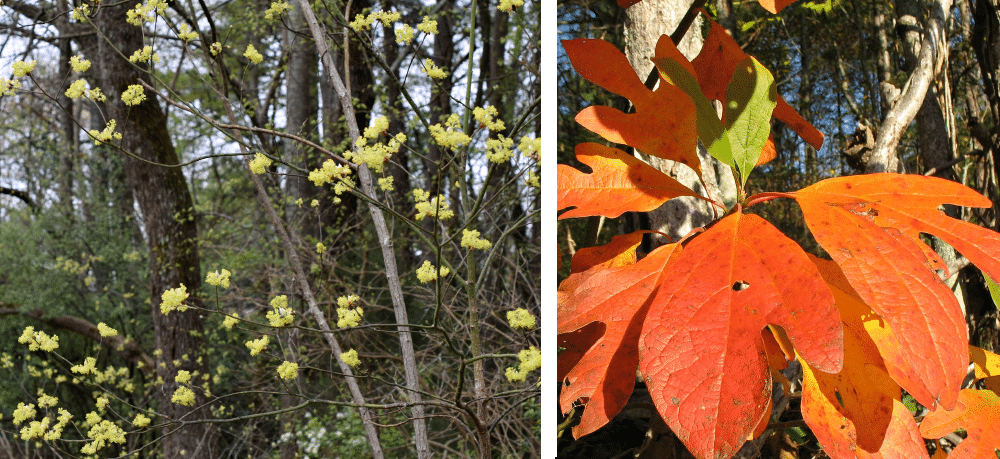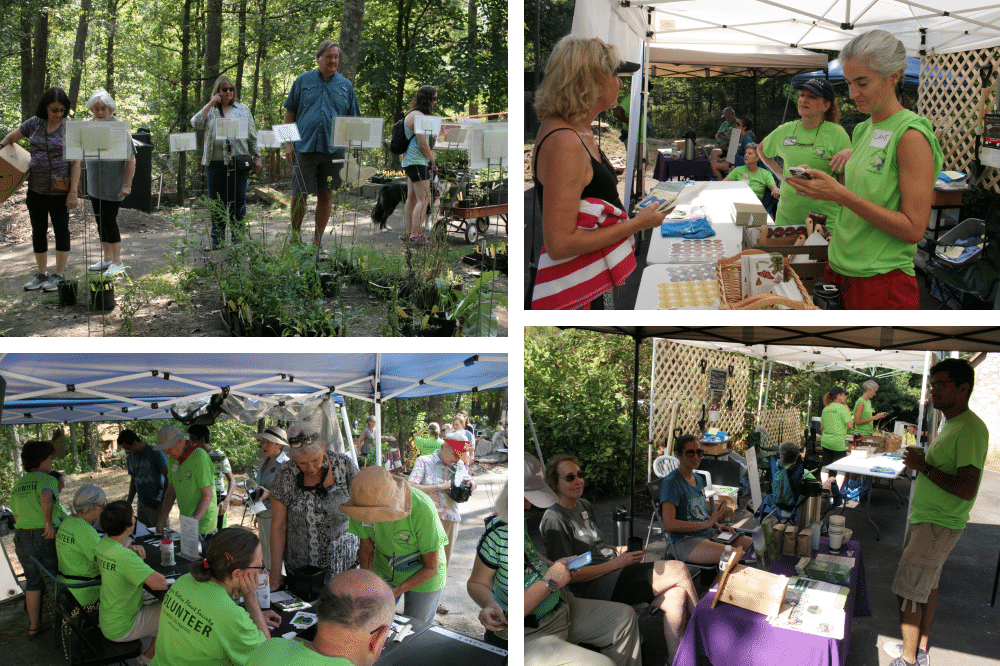November meeting
Our last program of 2018, to be held on November 13 at the Atlanta Botanical Gardens, will feature a presentation from Shan Cammack, Georgia Department of Natural Resources fire safety officer. Shan will present Burning for Biodiversity and share benefits of prescribed burns on native plant communities. The meeting also includes the ever popular GNPS native seed swap! Ellen Honeycutt and Karen McCaustland will be hosting the seed swap. Please bring your seeds to swap with both common and botanical names. Linda Fraser will also be bringing her fabulous botanical prints that make wonderful holiday gifts. You will not want to miss this evening! Specific details, as always, are at the GNPS Calendar. A video preview of the featured speaker is linked there, too.
Symposium: Save the date!!!
 The 2019 GNPS Symposium is scheduled for Saturday, March 2nd, 2019 in Macon. An exciting lineup of five distinguished presenters includes two keynotes Rick Darke and Doug Tallamy, authors of The Living Landscape. The 2019 GNPS Symposium is scheduled for Saturday, March 2nd, 2019 in Macon. An exciting lineup of five distinguished presenters includes two keynotes Rick Darke and Doug Tallamy, authors of The Living Landscape.
The Symposium does not just happen. It needs the help of many volunteers, and we are looking for a co-chair who loves to organize this type of special event. You do not need to be the greatest expert on plants, but if you have a knack for planning and working with people, you could be the one. Contact info@gnps.org, at least to start the conversation.
Plant of the Year is underway

Each year, we celebrate one special native plant by selecting it as GNPS Plant of the Year (POY). POY online voting is easy. Just log on to the GNPS website, go to the voting page, click to make your selection, and click on the Submit button. Online voting will remain open until Nov 12 at 6 pm. Members who don’t vote online are welcome to vote in person by paper ballot at the November 13 meeting. The last few years have seen some really close contests, with only a few votes separating the winner from the runner up. Your vote matters! So get in there and pick the plant you think is best for POY 2019!
Chapter News: Redbud
Margaret Rasmussen

November program speakers Joel Volpi (left) and John Rockers (right).
Master birder introduces Georgia birds to Redbud Chapter
Naturalist Joel Volpi is a steward of the Earth! From his local Georgia home and beyond our US borders, he spends his time and energy working to protect native plants, wildlife and their natural habitats. At Redbud Chapter program Birds of the Chattahoochee, Volpi gave a birder’s primer on how to recognize, attract and protect resident and migratory birds in their eco-regions. A retired educator, he shares his expertise as a lifelong birder to help ordinary human beings appreciate the birds of Georgia.
To identify birds by sight, he informs birders how to detect a bird’s distinctive markings, and spreads his arms as a bird in flight to demonstrate their identifying wing spreads and flight patterns. To identify birds hidden by dense foliage or too faraway to sight, biologists count birds in the field from sound rather than sight. Volpi shares the mnemonics of a bird then chirps and whistles and trills to help beginners identify birds by sound:
Barred owl (Strix varia), “Who cooks for you”
Tufted titmouse (Baeolophus bicolor), “Peter peter peter peter”
Northern cardinal (Cardinalis cardinalis), “woit woit woit chew chew chew”
Carolina wren (Thryothorus lucovicianus), “tea-kettle, tea-kettle, tea-kettle”
Red-eyed vireo (Vireo olivaceus), “eeyay, oolee, eeyup.”
To attract and protect resident and migratory birds, Volpi encourages providing birds with natural bird food from native plant ecosystems and landscapes that appeal to Georgia’s birds. A few recommended plants include Trumpet Vine (Campsis radicans), Blackeyed Susan (Rudbeckia hirta), Purple Coneflower (Echinacea purpurea), and Crossvine (Bignonia capreolata). A resident of Cornelia, Georgia, Joel Volpi is president of Soque River Water Shed Association and past president of Atlanta Audubon Society.
Plant collection donated to Redbud for nature preserve restoration
With the donation of his treasure trove of native plants, naturalist-horticulturalist John Rockers takes the Redbud Chapter’s restoration of Linwood Nature Preserve to a whole new level. The more than 200 southeastern US native species trees, shrubs, forbs and vines donated to Redbud Chapter in September were propagated by Rockers from native plants obtained on GNPS rescues or from other sites with permission of private landowners.
Over 15 years ago, Rockers began landscaping with native plants, replicating native plant ecosystems in his suburban landscape. As he studied native plants growing naturally in the wild, he began propagating plants to have specimen species in his small “native nursery.” His hobby as a native plant collector turned serious seven years ago with his discovery of an article by GNPS rescue coordinator Ellen Honeycutt, who offered him several of her own plants and invited him to join the Georgia Native Plant Society (GNPS).
Rockers’s perennial shrubs, tree saplings, herbs and vines will be incorporated into highly visible areas of the 30-acre urban forest of Linwood Nature Preserve. As GNPS Chapter naturalist-horticulturist, Rockers will oversee placing the plants in their desired habitats consistent with plans for Redbud’s proposed native plant walk and perimeter plantings. Installation of the Rockers native plant collection into Linwood Nature Preserve will further the mission of the Redbud Project for public education of native plants and conservation of their natural ecosystems imperiled by unsustainable economic development. John Rockers’s transformation from native plant hobbyist to native plant naturalist fits with the Redbud Project mission for environmental conservation.

John Rockers with Redbud Project volunteers Carol and Rich Hershey.
Rocker's transition from hobbyist to naturalist was seeded in 2003, when he realized the cost of commercially grown hybrid landscape plants & flowers seemed to double every year, fall and spring. Reflecting on his approach to landscaping, he remembers back to his youth growing up on a farm. “My father taught me not only about trees and the woodlot for an income source, but Dad opened my eyes to the natural world and habitats of the trees in the wild woods. I also became aware long ago that my part-Cherokee grandmother believed in the medicinal power of certain native forbs and how elderly Cherokee placed spiritual reverence on some native specimens, such as the Eastern Red Cedar tree,” he recalls.
With his commitment to Redbud chapter’s restoration of the nature preserve, Rockers hopes to pursue certification in native plants through an official Naturalist Training Program. A member of the Georgia Native Plant Society since 2011, Rockers has been active in environmental education and native plant identification with the Redbud Chapter since 2017. Redbud Project Chapter of the Georgia Native Plant Society partners with Gainesville Parks and Recreation to develop Linwood Nature Preserve for public access to leisure recreation in nature and for environmental education.
Plant Spotlight: Sassafras — Tree of many talents
Ellen Honeycutt

Sassafras in spring and fall. Note the three leaf types: single, two lobes, and three lobes.
Do you find common and Latin plant names confusing? Well, Sassafras is easy to remember because it works for both – Sassafras albidum is the Latin name too. Sassafras is a small to medium-sized deciduous tree that is native throughout Georgia. It is often known these days for two characteristics: the plant has 3 possible leaf shapes, including the well-known “mitten” shape; and it has beautiful orange fall color. Some people might remember that it has been used for flavoring and medicinal qualities in the past, but the FDA has banned the use of it now because of the carcinogenic properties of safrole (look for safrole-free sassafras oil instead). Powdered sassafras leaves are used to make filé, a thickening agent for gumbo.
The sassafras tree is also very beneficial to nature. It is our earliest tree to bloom in North Georgia, the clusters of small greenish-yellow flowers supporting the earliest of pollinators like small bees. Sassafras is dioecious, so male and female flowers develop on separate trees. Female flowers become drupes (berries) that are relished by birds in the fall. The foliage of sassafras supports the caterpillars of several large butterflies including the Eastern Tiger Swallowtail and the Spicebush Swallowtail as well as a number of large moths such as the Imperial Moth.
Sassafras is easy to grow in the residential landscape and should be used more often; it was our GNPS Plant of the Year in 2013, a recognition by our members that it deserves more use. It is a handsome tree from spring to fall, as far as humans are concerned, and it provides good support for the wildlife that lives with us. Fall is an excellent time to plant trees and shrubs in Georgia. Cool days and abundant winter rainfall help them get established better than any other time.

Sassafras flower and range map (source: USDA). There are definitely specimens in some unmarked counties! Go to the USDA Plants Database to learn how to submit a distribution update.
Natural communities and birds at Sweetwater Creek
Leslie Edwards

Clockwise from top left: Beech drops, parasitic upon the roots of American beech, photo by Irenee Payne; Ground nut in flower, photo by Jay Pakchar; Climbing hemp in flower, photo by Irenee Payne; Virginia willow (or sweetspire) with fall color, photo by Jay Pakchar.
We had an inspiring day exploring natural communities — including birds, insects, and ecology — in Sweetwater Creek State Park. The group included members of the Georgia Native Plant Society, the Georgia Botanical Society, and Atlanta Audubon, all learning from each other, whether listening to the call of a pileated woodpecker, examining a beetle in the leaf litter, observing caterpillars devouring oak leaves, or admiring the flowers of parasitic beech drops.
We spent time in moist (mesic) forests with mature beech trees (Fagus grandifolia ), northern red oaks (Quercus rubra), and tulip-trees (Liriodendron tulipifera). In places, the forest floors were lushly carpeted with New York fern (Parathelypteris noveboracensis); in others, giant cane (Arundinaria gigantea) indicated that we were grading into bottomlands. On higher slopes, the forests transitioned to oak-hickory-pine forest dominated by white oaks (Quercus alba), and the ground cover was sparser. We encountered picturesque swathes of sedges (most likely a Carex sp.), the blooms of white wood aster (Eurybia divaricata), the purple flowers of common elephant’s-foot (Elephantopus tomentosus), clumps of Christmas fern (Polystichum acrostichoides), and the gorgeous fruits of heart’s-a-burstin’ (Euonymus americanus). We enjoyed looking closely at the capsule fruits of cranefly orchid (Tipularia discolor) and the fertile frond of rattlesnake fern (Botrypus virginianus), while also stepping back to consider the global specialness of deciduous forests, their wildlife food, and ecological processes. Mixed flocks of birds – migrating warblers along with titmice and chickadees – flitted through the trees.
We ended along the spectacular flowing waters of Sweetwater Creek. Streamside thickets were bursting with classic wetland plants. Many were in fruit, including the globular seed heads of buttonbush (Cephalanthus occidentalis); the berries of swamp dogwood (Cornus amomum); and the capsules of Virginia willow (Itea virginica). Others were in in flower, including climbing hempvine (Mikania scandens), ironweed (Vernonia alternifolia), jewelweed (Impatiens capensis) and hollow stem joe pye weed (Eutrochium fistulosum). One iconic wet meadow by the stream hosted monkey flower (Mimulus ringens), ground nut (Apios americana), a boneset (Eupatorium sp.), and seedbox (Ludwigia alternifolia), all in bloom alongside a lush patch of arrow arum (Peltandra virginica). Riparian trees, such as river birch (Betula nigra), sycamore (Platanus occidentalis), and green ash (Fraxinus pennsylvanica), arched over the water. Small, pictuersque glade-like areas hosted purple asters (Symphyotrichum spp.) and goldenrods (Solidago spp).
We also gazed up at the high ridge looming from the other side of Sweetwater Creek. There, the exposed, rocky ridge once hosted several mature longleaf pines (Pinus palustris), now no longer alive. Several more have been planted, in a very dry natural community dominated by post oak (Quercus stellata), blackjack oak (Quercus marilandica), and rock chestnut oak (Quercus montana). The contrast in natural communities was vivid, and a good reminder that plants truly do have a right place.
Fall plant sale recap
Thanks to all of the volunteers who contributed to yet another GNPS plant sale success. Our second annual Educational Festival continued to help spread the word about plants, pollinators, and conservation, highlighting our partnerships with Atlanta Audubon and Pollinator Friendly Yards, while introducing a new booth where we provided landscaping advice to visitors.

|